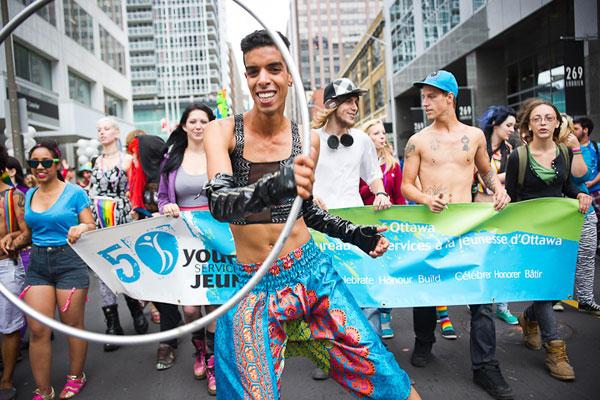You’ve probably spotted him while wandering the streets of Ottawa.
Maybe you saw him with a glow-in-the-dark Hula-Hoop, busking in the market or spontaneously performing at a Tegan and Sara concert. His outfits range from outrageous dresses to fishnets with heels, tank tops or skinny jeans and meticulously applied makeup.
“Who is that glittery, bronzed gaydonis?” you may have wondered.
Meet 21-year-old Myron K.
He might seem like your typical party-loving, glam twink who’s destined for the New York club circuit rather than asleep-by-11 Ottawa. But when I sat down with this social rainbow-coloured butterfly for a pot of tea, he revealed that he is more than just a pretty face.
“I’m at my prime,” he says, laughing. “You can say I’m going through an awakening.”
Myron is currently leader of the Youth Services Bureau’s (YSB) ethnocultural youth advisory committee (EYAC), spearheading a needs assessment program for queer youth who are newcomers to Canada or first-generation immigrants.
His final report will cover issues relevant to queer youth of colour, including cultural topics, mental health, safe spaces and other services. Myron hopes to underscore the need for further funding to implement sorely needed youth programs.
In addition to his YSB career, he is a full-time student in Algonquin College’s child and youth worker program.
Myron says activism came naturally when he came out.
“I spent my whole life trying to figure out my sexuality,” he says, sipping his chamomile tea. “Before I turned 19, I finally came out to my amazing circle of friends. They were welcoming and supportive.”
Coming out to his family, though, was a different story.
“My family is Iraqi, and even though I was born and raised in Ottawa, I was also raised Muslim. I’m not saying all Iraqis or all Muslims aren’t welcoming. It’s just my cultural community has a certain mindset and ideological perspective where I was raised to believe that homosexuality was wrong. Plus, this kind of community is very reputation-based, and just being yourself can harm your family, so I knew I couldn’t just come out to them.”
Myron remembers uncomfortable conversations when his father would point out strangers in the street and say, “See that gay guy? He’s going to Hell.”
Overcoming the guilt from internalized homophobia took a combination of personal work, peer support and a YSB counsellor who intimately grasped the ethnic issues Myron was going through.
“I de-stigmatized homosexuality to myself through my peers,” Myron says. Through firsthand experience, he discovered that being gay didn’t mean he was a bad person.
His YSB counsellor became a pivotal influence.
“I realized the significance of having someone there for me that was sensitive to the issues of culture and sexuality.” The counsellor guided Myron “to the most knowledgeable, beneficial choices.” YSB also provided an Arabic translator to help Myron write a coming-out letter to his family so he could explain why he no longer felt safe at home and had to run away.
After he moved out, Myron began volunteering at YSB. He felt it was important to give back.
“I find the Ottawa queer community to be so loving and supportive. I also find it to be lacking some awareness and programming for ethnic LGBTTQ people. I have had so much support within my peer group and the Youth Services Bureau, and I just want to give others the same respect and unconditional support I received.”
His passion to help other youth soon flowered into a full-fledged career and “life calling” to create a more inclusive Ottawa. He has delivered workshops to service providers and schoolteachers on newcomer concerns and has advocated for queer issues at conferences.
Myron won’t disclose his full name because he says he hopes to reconcile with, and protect, his family. Part of his personal awakening has involved realizing the importance of also advocating for himself and his loved ones.

 Why you can trust Xtra
Why you can trust Xtra


